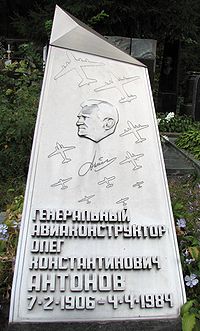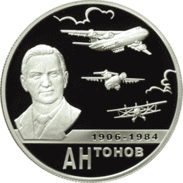- Oleg Antonov
-
Oleg Konstantinovich Antonov (Ukrainian: Оле́г Костянти́нович Анто́нов, Russian: Оле́г Константи́нович Анто́нов, 7 February 1906, Troitsy, Moscow province, Russian Empire – 4 April 1984, Kiev, Ukrainian SSR) was a Soviet aircraft designer, the founder of Antonov ASTC, a world-famous aircraft company in Ukraine, later named in his honour.
Contents
Early life
Antonov was born on 7 February 1906 in a village near Moscow. In 1912, the Antonovs moved to Saratov, where he attended the local technical school. From an early age, Antonov was fascinated with aviation and spent much of his spare time at the local airport.
Aviation career
At the age of 17, Antonov founded the "Amateur Aviation Club" and the "Organization of Friends of the Air Force." In the same year, he designed the OKA-1 "Pigeon", a glider that was entered in a competition in Moscow where he won the first prize, a flight on a Junkers 12 aircraft.[1]
In 1930, Antonov graduated from the Kalinin Polytechnical Institute in Leningrad. He continued to design gliders and in 1931, Antonov became the chief designer of the Moscow Glider Factory. During the next eight years, he designed 30 different gliders including the Standard-1, Standard-2, OKA-6 and the large "City of Lenin" glider. Due to a requirement that all pilots in the Soviet Union had to begin their flight training on gliders, Antonov was able to produce up to 8,000 gliders per year.[1]
In 1938, due to an incident when an instructor defected to the West using a glider, the Soviet government reversed its decision regarding glider training, banned the sport of gliding and shut down the Moscow Glider Factory. Following the close of the glider factory, Antonov was hired as the Chief Designer for Yakovlev Aircraft. In 1940, a new company in his own name was created in Leningrad.[1]
World War II
During the war, Antonov designed the A-7 troop and supply glider used to supply partisans and the KT "Kryl'ja Tanka" or "Tank Wings" biplane glider that was designed to transport tanks to the front line. In 1943 Antonov returned to Yakovlev’s design bureau to fill a vacancy as Yakovlev’s deputy. A great deal of his time and energy was devoted to the improvement of the Yak series, one of the most mass-produced fighter aircraft types of World War II.[1]
Volga-Dnepr An-124-100
Postwar
After the war Antonov requested Yakovlev to let him work independently, heading Yakovlev’s subsidiary design office at the aircraft manufacturing factory at Novosibirsk. On 31 May 1946, Antonov was appointed head of the newly redesignated facility known as the Antonov Aircraft design bureau, later moved to Kiev, Ukraine. In September 1946, Antonov, in addition to his management of the design bureau, became the Director of the Siberian R and D Institute for Aeronautics.[1]
The first of the bureau's designs was the SH-1 agricultural aircraft, later redesignated An-2 designed to meet a 1947 Soviet requirement for a replacement for the Polikarpov Po-2 which was used in large numbers as both an agricultural aircraft and a utility aircraft. Antonov designed a large single bay biplane of all-metal construction, with an enclosed cockpit and a cabin with room for seats accommodating 12 passengers.
A series of significant transports followed including the world's largest production aircraft.
Antonov's aircraft (design office prefix An) ranged from the rugged An-2 biplane (which itself is comparatively large for a biplane) through the An-28 reconnaissance aircraft to the massive An-124 Ruslan . The quad turboprop An-12 was primary Soviet military transport aircraft since 1959 (similar to the C-130 Hercules). While less famous, the An-24, An-26, An-30 and An-32 family of twin turboprop, high winged, passenger/cargo/troop transport aircraft are important for domestic/short-haul air services particularly in parts of the world once led by Communist or former Communist governments. The An-72/An-74 series of small jetliners is slowly replacing that fleet and a larger An-70 freighter is under certification. The An-70 is outwardly similar[dubious ] to the Airbus A400M design that had its first flight December 11, 2009. Some of Antonov's designs are also built abroad such as the Shaanxi Y-8.
Antonov was a Doctor of Science, academician of the Academy of Science of the Ukrainian SSR (1968), Hero of Socialist Labor (1966), member of the Supreme Soviet of the USSR of the 5th, 6th and 7th convocations.
Awards and legacy
 Oleg Antonov's grave on Baikove Cemetery in Kiev, Ukraine.
Oleg Antonov's grave on Baikove Cemetery in Kiev, Ukraine.
- Antonov received the State Award of the USSR in 1952 and Lenin Award in 1962.
- Antonov was also decorated with two Orders of Lenin and other orders and medals.
- The Antonov design bureau has the distinction of making huge and powerful aircraft throughout its existence.
- In November 2004, FAI placed the An-225 in the Guinness Book of Records for its 240 records. The highly popular AN-124 "Ruslan" is used worldwide for cargo transport.
- A street in Kiev city is named after Oleg Antonov.
- A coin was minted of Copper Nickel Alloy in 2006 by the National Bank of Ukraine honoring Antonov. In addition, a silver proof coin was issued by the Bank of Russia to commemorate 100 years since Antonov's birth.
References
- Notes
- Bibliography
- Anisenko, Viktor G. O.K. Antonov: Versatility of Talent. Aero Hobby PC.
- Gordon, Yefim. Antonov An-2: Annushka, Maid of All Work-Red Star Volume 15. Hersham, Surrey, UK: Midland, 2004. ISBN 978-1857801620.
External links
Categories:- 1906 births
- 1984 deaths
- Russian aerospace engineers
- Ukrainian aerospace engineers
- Russian engineers
- Ukrainian engineers
- Russian inventors
- Ukrainian inventors
- Heroes of Socialist Labour
- Soviet engineers
- Soviet aerospace engineers
- Soviet inventors
Wikimedia Foundation. 2010.




